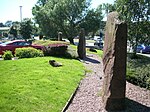Great Barr Hall
Buildings and structures in WalsallCountry houses in the West Midlands (county)Geographic coordinate listsGrade II listed buildings in the West Midlands (county)Great Barr ... and 3 more
Lists of coordinatesLunar Society of BirminghamStructures on the Heritage at Risk register

Great Barr Hall is an 18th-century mansion situated at Pheasey, Walsall, on the border with Great Barr, Birmingham, West Midlands, England. It has associations with the Lunar Society and is a Grade II listed building. It is, however, in a very poor state of repair and is on the Buildings at Risk Register.
Excerpt from the Wikipedia article Great Barr Hall (License: CC BY-SA 3.0, Authors, Images).Great Barr Hall
Sutton's Drive,
Geographical coordinates (GPS) Address External links Nearby Places Show on map
Geographical coordinates (GPS)
| Latitude | Longitude |
|---|---|
| N 52.556283 ° | E -1.920961 ° |
Address
Great Barr Hall
Sutton's Drive
B43 7BQ
England, United Kingdom
Open on Google Maps





